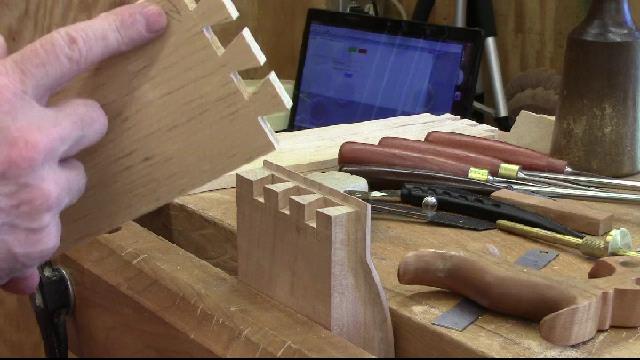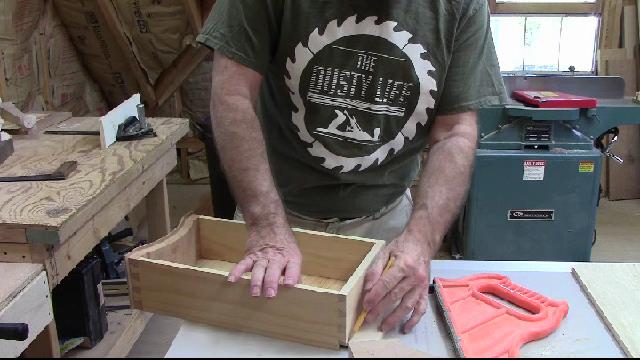For a detail discussion on half blind dovetails, here is a link to a prior video. Curved Blockfront Dressing Table Detail Half Blind Dovetails & Drawer Bottoms Step 20
I am chopping out the half blind dovetails for the drawer fronts. These are 5/8 inch long. I have sawed on the waste side of the line. With my small dovetail chisel, I am able to feel the line that I scribed with the Lee Valley wheel marking gauge. I set the chisel in the groove and start to remove the waste material.
After removing the waste to the bottom of the socket, again I am able to put the chisel in the groove and slice out the last of the material for a nice clean edge on the bottom.
Below I am cleaning up the sockets to make sure they are at right angles to the dovetails.
Here is another time when I use my number marking on the insides of the drawer. This is a number IV and it matches the one on the drawer front. (I use Roman Numerals)
If I have been careful with my sawing and chopping, the dovetails should fit right in. Looks like a good fit.
After all the dovetails have been fitted, I need to put a 1/4 inch groove in the sides 1/4 inch from the bottom. This is the groove for the drawer bottoms. I have made a reproduction of a Sandusky 119 plough plane. It designed to make grooves just like the one that we need here so I used it to groove the drawer sides. It is much quieter than the electric router or table saw.
Now I use the band saw to cut out the back of the drawer fronts. They are curved both front and back.
The curve in the back is the same radius as the front. Once it is removed the drawer fronts are 1 inch thick.
Now the tricky part, I could use a very small router plane to cut a 1/4 inch groove in the back of the drawer fronts. But I decided to use the electric router with a large baring to make the 1/4 inch groove. This groove is stopped so it does not go through the ends and should not be seen on the sides of the drawers. I use a chisel to finish the groove.
I cut 7 3/4 inches for the drawer bottom from the 1/2 inch pine that I glued up in the prior post and video.
Now I need to put a bevel on the drawer bottom so that it fits in the 1/4 inch groove. I use my router with a large bevel bit. After a couple of passes I have the correct cut and thickness.
Early in the morning the sun comes in that window. It makes quite a contrast
I slide the bottom into the drawer and trace the curve in the front on to the bottom and then cut out the curve on the band saw. This way the bottom curve is sure to match the front groove.
After I cut out the curve, I run it back through the router bevel bit again to finish the curved bevel in the front. It is an extra step to do it this way but it make a good fit in the curved front.
Now all I need to do is slip it in the groove.
I left out the step where I cut 1/2 inch off the back of the drawer to make an opening so the drawer front would slip in.
The drawer bottom is a little too long. I will cut it off later but still leave about 3/16 inch sticking out the back. It will be nailed in the back to hold it in.
That's how it was done in the 18th century. Without the power tools.
Next post I will work on the knee blocks and turned finials.
Here is today's video:















No comments:
Post a Comment